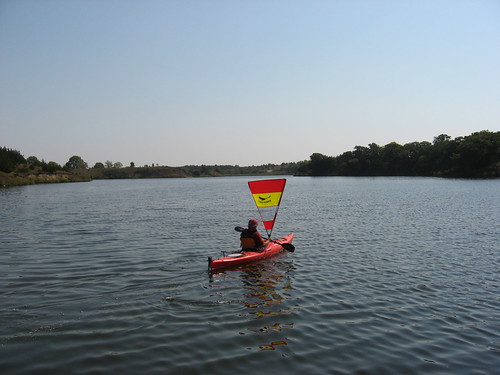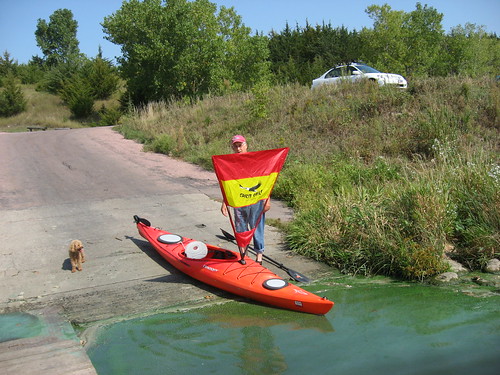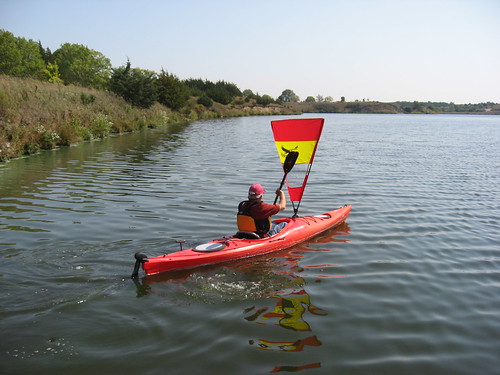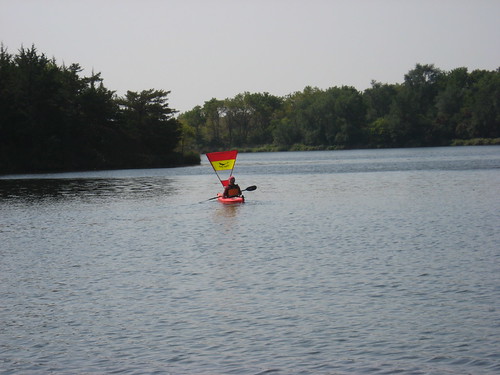
The sail for my kayak that I ordered from Spirit Sail arrived while I was in California visiting old Peace Corps pals. This past weekend was the first chance for me to try out the sail in light winds. A day or two before, the wind was blowing 25 miles per hour, and I thought that it would be best to make a first effort at sailing the kayak with a real sail under milder conditions. So, on Saturday, the winds were light, probably too light. In the morning, I looked out at the trees and saw leaves slightly moving. But, this was the day, and I just hoped that there would be some wind at Lake Alvin. The weather bureau reported winds at just over 5 mph, and for South Dakota that is almost a flat calm.
I headed out to Lake Alvin with Marsha and our dog; our Saturday routine always calls for a walk in one of the nearby nature areas around noon. Lake Alvin seemed okay for both needs – a walk for Marsha and Finnegan and a try-out of the sail for me.

Earlier, I had attached the sail mount to my kayak. I drilled out four holes on the fore deck of the kayak and, with some difficulty, managed to get the mount attached along with a backing plate on the bottom of the deck. The mount has a fitting to attach the sail, and it is possible to rig the sail while underway. I needed to practice attaching the sail and adjusting it, as well as sailing the kayak downwind.


The sail is called a “downwind rig” and is akin to sledding down a hill. As long as the boat is running within 30 degrees either way of the wind direction, the sail should draw. There are three settings for the mast, and the sail can be adjusted by grasping the mast mount, lifting it free of its seat, and adjusting it for straight downwind sailing or sliding it to either the left or right to the 30 degree mark for sailing slightly off the wind. It is by no means a sail that would permit tacking. My rudder acts somewhat like a centerboard.

The sail can be used for messing around on a lake as long as the kayak is placed in a position where the direction of travel is downwind. Like a sled, the kayaker might have to paddle upwind to a point and then sail back. If the direction of travel were to be lengthy, such as on a wide or long body of water, the sail might ease the burden of paddling and be used to effortlessly move along.

The sail can also be used just as a chance to experience the most rudimentary form of wind-born travel. Many of the features of sailing are there: the draw of the sail, the luff in a sail as the wind shifts across its surface, the snap of the sail as the wind grabs it, and the sound of water passing under the hull just from the pull of the sail.

This sail is called the “mid-size” and is billed as good for “older (geezer)” sailors. The sail area is only 8.5 feet, not really much more that my big golf umbrella. The advantage of the sail over my umbrella is that my hands are free to balance the paddle for a potential brace or draw. I steer the boat with my foot-operated rudder.

On this occasion, I found myself more concerned with operating the sail than in enjoying the time on the water. I paddled from the dock in the Lake Alvin Recreation Area down to the fishing dock and then sailed back. The sail back was slow with the wind conditions. I could have easily have raced myself with just a leisurely paddle. But then, I chose a day with limited wind. I want to try it again with the wind about 10 mph and see how the boat moves. For now, I have the sail in its bag and will carry it in the bottom of the kayak on future paddles. When the occasion presents itself, I will set up the sail and continue to learn how to use it effectively.

There is a certain irony in using a sail with the kayak. I got the boat, in large part, to provide another avenue for exercise – a form of exercise that is very appealing to me. The sail might reduce the exercise aspect of kayaking, and that would not be good. Also, it is not the effort of paddling that tends to bring on fatigue for me; it is, instead, the time spent sitting in the boat. I can only endure a couple hours before getting out and walking around. At my advanced age, four hours total is about my daily limit of paddling.

For now, however, I can imagine those first days of sail as early man set out in dugout canoes with a scrap of sail to ease the effort. My sail is very similar to those earliest devices.
By the way, the regional magazine Living Here did a feature story of me in their fall issue. The cover is one of my photos of kayaking Split Rock Creek among the rock palisades.

